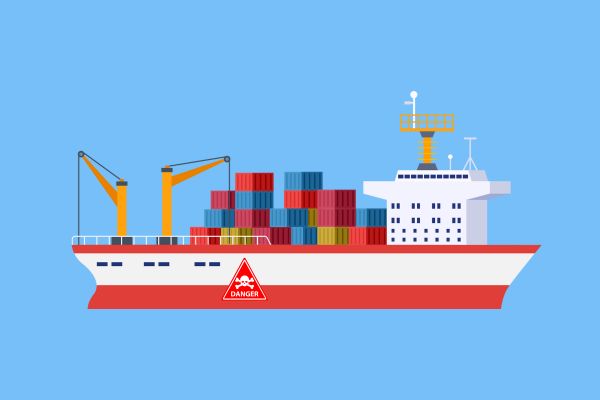From May 15, 2024, what are the requirements for individuals loading and unloading dangerous goods on inland waterway vessels in Vietnam?
From May 15, 2024, what are the requirements for individuals loading and unloading dangerous goods on inland waterway vessels in Vietnam?
Pursuant to Article 15 of Decree 34/2024/ND-CP, the regulation on loading and unloading and storage of dangerous goods in warehouses or yards in Vietnam is as follows:
Individuals loading and unloading dangerous goods must comply with the regulations on cargo loading on inland waterway vessels and the following provisions:
(1) The loading and unloading of dangerous goods must be directly guided and supervised by the warehouse keeper, the leaseholder, or the escorting personnel. The captain decides the loading scheme for dangerous goods on the vessel and the appropriate padding and securing of the goods based on the nature of each type or group of dangerous goods. Incompatible dangerous goods should not be loaded together in the same compartment or hold to prevent increased danger.
(2) In cases where the transport of dangerous goods does not require escort, the transporter must load and unload the goods following the leaseholder's instructions.
(3) For types or groups of dangerous goods that must be loaded, unloaded, and stored separately, the operation must be carried out in dedicated port, dock, or warehouse areas.
(4) Once all dangerous goods have been removed, the storage area must be cleaned to avoid affecting other goods.
Thus, individuals loading and unloading dangerous goods on vessels and in storage facilities using inland waterway means must comply with the 04 requirements listed above.

From May 15, 2024, what are the requirements for individuals loading and unloading dangerous goods on inland waterway vessels in Vietnam? (Internet image)
Which authority has the power to grant dangerous goods transport licences in Vietnam?
Pursuant to Article 17 of Decree 34/2024/ND-CP, the regulation on the authority to grant dangerous goods transport licences in Vietnam is as follows:
Authority to issue and cases exempt from dangerous goods transport licences
1. The Ministry of Public Security organizes the issuance of permits for the transportation of dangerous goods of types 1, 2, 3, 4, and 9 as stipulated in Clause 1 Article 4 of this Decree (excluding pesticides and as specified in Clause 2 of this Article).
2. The Ministry of National Defense organizes the issuance of permits for the transportation of dangerous goods for organizations and enterprises under its management.
3. The Ministry of Science and Technology organizes the issuance of permits for the transportation of dangerous goods of types 5 and 8 as stipulated in Clause 1 Article 4 of this Decree.
4. The provincial-level People's Committees organize the issuance of permits for the transportation of dangerous goods that are pesticides.
5. The permit-issuing agency determines the transport route and period based on the type or group of dangerous goods as stipulated in Clause 1 Article 4 of this Decree.
6. The issuance of permits for the transportation of dangerous goods type 7 is conducted in accordance with the regulations on radiation work and support services related to the application of nuclear energy.
7. Permit-issuing agencies can refuse to issue permits for the transportation of dangerous goods that are flammable or explosive substances through tunnel or ferry projects as stipulated in Article 12 of this Decree.
The dangerous goods transportation permit is issued by competent agencies of the Ministries. Additionally, the provincial-level People's Committees organize the issuance of permits for dangerous goods that are pesticides.
What are the requirements for participants in transport of dangerous goods on inland waterway routes in Vietnam?
Pursuant to Article 13 of Decree 34/2024/ND-CP, the requirements for participants in transport of dangerous goods in Vietnam are as follows:
(1) Crew members and operators of inland waterway vessels carrying dangerous goods must be trained and possess a special professional certificate related to dangerous goods transportation as prescribed by the Minister of Transport. They must also be trained and certified as having completed the safety training program for dangerous goods as stipulated in this Decree.
(2) Escorts, warehouse keepers, and individuals loading and unloading dangerous goods on vessels and at inland waterway ports must be trained and certified as having completed the safety training program for the dangerous goods they escort, load, unload, or store.
Thus, individuals participating in the transportation of dangerous goods must meet the 02 conditions stated above.
Besides, Article 14 of Decree 34/2024/ND-CP stipulates requirements for inland watercraft carrying dangerous goods in Vietnam as follows:
Requirements for inland watercraft carrying dangerous goods
1. The transport vehicle must meet the conditions for traffic participation as prescribed by law.
2. The transport vehicle for dangerous goods must bear the dangerous goods symbol. If the vehicle carries multiple types of dangerous goods, it must bear sufficient symbols for those types. Symbols should be placed on both sides of the vehicle.
3. A transport vehicle for dangerous goods, after unloading, if no longer carrying that type of goods, must be cleaned, and the hazardous symbol on the vehicle must be removed. The transport unit, crew, or operator of the inland waterway vessel is responsible for cleaning and removing the hazardous symbol when the vehicle is no longer carrying dangerous goods.
Transport vehicles for dangerous goods must meet the legal conditions for traffic participation, including bearing the dangerous goods symbol as required and cleaning the symbol when no longer transporting dangerous goods.
LawNet